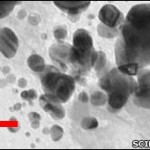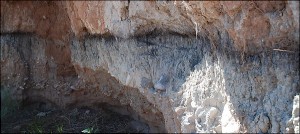Nor a Clovis indian’s, either. Nanodiamonds are teeny tiny invisible-to-the-naked-eye fragments of diamonds created by enormously high pressure and heat.
 Researchers have found thin layers of them all over North America right at the 13,000 year old level, which is when a global cooling period called the Younger Dryas began, extinguishing the human and large mammal populations of the continent.
Researchers have found thin layers of them all over North America right at the 13,000 year old level, which is when a global cooling period called the Younger Dryas began, extinguishing the human and large mammal populations of the continent.
Bones of these animals, and Clovis artifacts, are abundant before this time. Excavations show a dark “mat” of carbon-rich material separates the bones and artifacts from emptier and younger layers.
Writing in the journal Science, Kennett and colleagues report they have evidence of the nanodiamonds from six sites across North America, fitting in with the hypothesis that a giant explosion, or multiple explosions, above the Earth’s surface cause widespread fire and pressure.
There is evidence these minerals can be found in other sediments, too, they said, and help explain the “black mat”.
“These data support the hypothesis that a swarm of comets or carbonaceous chondrites (a type of meteorite) produced multiple air shocks and possible surface impacts at 12,900 (years ago)” they wrote.
The nanodiamonds were only found in Younger Dryas layers, not above or below, so their discovery supports the catastrophic comet theory.
There are no major craters indicating impact, though, so if the comet idea is true, it might have exploded in the atmosphere generating a huge shockwave of heat and pressure that layered the continent in invisible diamonds, killing every beast around and plunging the world into an ice age.
Nicholas Pinter, a geologist at Southern Illinois University, said he had yet to see classic evidence of an asteroid impact.
The so-called discrete layers of material were not of a uniform age, he said. Microspherules, for example, rain down all the time and are present throughout the geological record.
“My graduate student found some on his mailbox,” said Dr Pinter.
While Dr Kennett proposed that ordinary carbon was forged into diamonds in the intense pressure of an airburst, Dr Pinter said nano-diamonds are now being identified at other locations and times without credible evidence of any impact.
The suggestion that they could have been produced by an airburst event is “untested and highly implausible,” he argued.

Here is a link to a related paper from respected archaeologist Vance Haynes. Don’t miss the photos of “Black Mats” in the supporting information:
http://www.pnas.org/content/105/18/6520
Most excellent. Thank you very much for the link. :hattip: